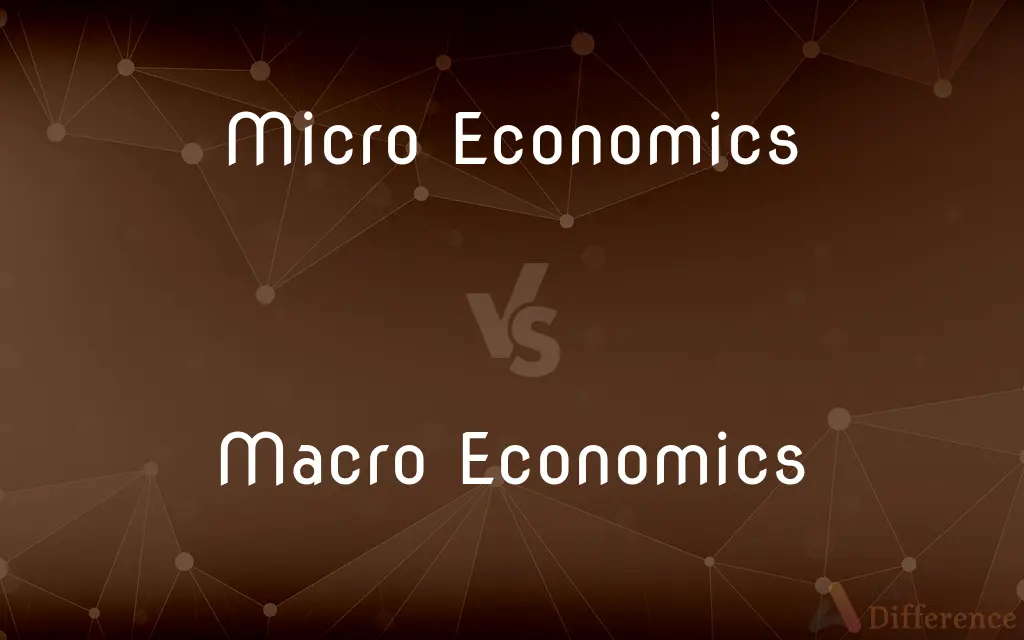Micro Economics vs. Macro Economics — What's the Difference?
Edited by Tayyaba Rehman — By Fiza Rafique — Published on December 16, 2023
Micro Economics studies individual economic units, while Macro Economics examines the economy as a whole.

Difference Between Micro Economics and Macro Economics
Table of Contents
ADVERTISEMENT
Key Differences
Micro Economics is the branch of economics that focuses on the behavior and decision-making of individual economic units such as consumers, firms, and households. It delves into the factors affecting individual choices and how these decisions impact market prices and quantities. In contrast, Macro Economics deals with the broader aspects of the economy, examining aggregate variables like national income, total employment, and general price levels.
Micro Economics often grapples with questions like how consumers make purchasing decisions or how firms decide on production levels. It seeks to understand the supply and demand in individual markets and the factors influencing them. On the flip side, Macro Economics is concerned with understanding economic indicators like GDP growth, unemployment rates, and inflation. It investigates the causes and consequences of changes in these aggregates.
In the realm of policy-making, Micro Economics provides insights on how individual sectors can be made more efficient, while Macro Economics guides national economic policies. For instance, Micro Economics might study the impact of a subsidy on the production of a particular good, whereas Macro Economics might analyze the effects of fiscal or monetary policies on the overall economy.
From an analytical viewpoint, Micro Economics uses tools like demand and supply curves to explain market outcomes. Macro Economics, however, employs models that depict the relationships between broader variables such as consumption, investment, and government spending.
While both Micro Economics and Macro Economics are integral to understanding the complexities of the economic landscape, they offer different lenses. Micro examines the trees in detail, while Macro provides a view of the entire forest.
ADVERTISEMENT
Comparison Chart
Focus
Individual economic units
Entire economy
Key Questions
How do consumers and firms decide?
What drives GDP growth or inflation?
Policy Application
Efficiency in individual sectors
National economic policies
Analytical Tools
Demand and supply curves
Aggregate demand and supply models
Typical Concerns
Pricing of a specific product
National unemployment rate
Compare with Definitions
Micro Economics
Analyzes market mechanisms at granular levels.
Micro Economics has provided insights into the dynamics of auction markets.
Macro Economics
Focuses on broad economic indicators and their interrelations.
Macro Economics helps policymakers understand the trade-offs between inflation and unemployment.
Micro Economics
Focuses on decision-making of single units.
Through Micro Economics, we can study a firm's production choices.
Macro Economics
Examines aggregate economic variables.
In Macro Economics, we study factors affecting the national unemployment rate.
Micro Economics
Study of individual economic behavior.
Micro Economics analyzes how a price increase affects consumer demand.
Macro Economics
Investigates economy-wide phenomena.
Macro Economics research has been pivotal in understanding inflationary trends.
Micro Economics
Examines supply and demand in specific markets.
Micro Economics helped assess the impact of a tax on cigarette sales.
Macro Economics
Provides insights into national economic policies.
Central banks use Macro Economics when setting interest rates.
Micro Economics
Understands factors affecting individual market outcomes.
Micro Economics research indicated that advertising can significantly influence consumer preferences.
Macro Economics
Study of the entire economy's performance.
Macro Economics revealed reasons behind last year's GDP growth.
Common Curiosities
Which branch deals with GDP and unemployment rates?
Macro Economics deals with broader indicators like GDP and unemployment rates.
How is Macro Economics different from Micro Economics?
While Micro Economics focuses on individual units, Macro Economics examines the entire economy's aggregate variables.
What is Micro Economics?
Micro Economics studies the behavior and decision-making of individual economic units like consumers and firms.
Why is understanding Micro Economics important for businesses?
Micro Economics helps businesses understand consumer behavior, pricing strategies, and market competition.
How do policymakers use Macro Economics?
Policymakers use Macro Economics to guide national economic policies, like fiscal or monetary strategies.
What are some tools used in Micro Economics analysis?
Demand and supply curves are foundational tools in Micro Economics.
Which branch might help understand the effects of a national recession?
The effects and causes of a national recession would be a focus of Macro Economics.
Can Micro Economic principles apply to the whole economy?
While Micro Economics offers insights at the individual level, Macro Economics provides a broader perspective for economy-wide applications.
Is consumer demand a Micro or Macro Economic concept?
Consumer demand is primarily a Micro Economic concept.
How does Macro Economics analyze the health of an economy?
Macro Economics uses indicators like GDP growth, inflation, and unemployment rates to assess economic health.
Can one specialize in both Micro and Macro Economics?
Yes, while they offer different perspectives, many economists have expertise in both Micro and Macro Economics.
How do Micro and Macro Economics interrelate?
While they focus on different scales, both branches often overlap and provide complementary insights into economic behavior and policy.
Which branch might study the impact of a new tax on car sales?
Such a specific impact would be studied under Micro Economics.
If a country faces high inflation, which branch offers insights?
High inflation and its causes would be analyzed under Macro Economics.
Does Micro Economics only deal with small businesses?
No, Micro Economics studies individual economic units, which can include both small and large businesses.
Share Your Discovery

Previous Comparison
Crew Cab vs. Quad Cab
Next Comparison
Defining Relative Clauses vs. Non Defining Relative ClausesAuthor Spotlight
Written by
Fiza RafiqueFiza Rafique is a skilled content writer at AskDifference.com, where she meticulously refines and enhances written pieces. Drawing from her vast editorial expertise, Fiza ensures clarity, accuracy, and precision in every article. Passionate about language, she continually seeks to elevate the quality of content for readers worldwide.
Edited by
Tayyaba RehmanTayyaba Rehman is a distinguished writer, currently serving as a primary contributor to askdifference.com. As a researcher in semantics and etymology, Tayyaba's passion for the complexity of languages and their distinctions has found a perfect home on the platform. Tayyaba delves into the intricacies of language, distinguishing between commonly confused words and phrases, thereby providing clarity for readers worldwide.
















































